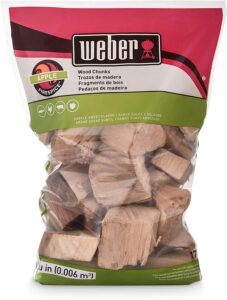Before you go ahead and add smoking chips or chunks to your smoker, it’s best to understand the different smoking wood flavor profiles. Wood chunks are a crucial component of any good smoking experience, and it can impart subtle flavors to your meat or fish. We’ve created the chart below to help pair your favorite meats to each of the wood varieties. There are many types of wood chunks for smoking meats – let’s take a look below.
There are several different wood varieties that can be added to your lump charcoal. Some of the more common woods are apple, cherry and hickory. We’ve all heard of hickory smoked chicken, but is it always the best use of flavor? The best flavor will always be the flavor that you prefer, regardless of what the chart says. However, if you’re not so sure where to start, the chart below will give you some direction. When it comes to smoking meats and using wood chunks, we all seek to get the coveted “blue smoke” from your smoker. Once the grill is lit and has come to temperature, the smoke will change in color from a dark smoke, to a clear bluish greyish smoke. Once you see the blue smoke, you know the smoker is ready for your meats.
High Quality Wood Chunks & Wood Flavors
If it’s your first time pairing woods with meats, we would recommend choosing a milder flavor. Sometimes the decision will be made based on what’s in stock at your local grilling store. Another topic to consider when buying smoking wood is whether they have wood chips or chunks available. When your shopping for wood chunks, often times the bag itself will tell you the wood flavor profiles. If you’re using a ceramic smoker (BGE, Kamado Joe), we would always recommend buying wood chunks. There are a lot of different brands and flavors available. Fogo, even sells bourbon barrel wood chunks.

The chips can be to small and will smolder/fizzle out for long cooks. I personally try to keep a stash of apple chunks and hickory chunks and mix it up from time to time. While smoking wood chunks are important, don’t forget to add seasonings and rubs to your meat. If I am just doing a quick barbecue of hamburgers or steaks, I may even forgo the chips altogether. I typically leave the wood chunks for long, slow and low cooks. Note, if you do end up using smoking wood chips, we’d recommend soaking the chips in water so that they do not burn out too quickly.
Smoking Wood Chart
When it comes to smoking meats there are different types of smoking wood. We’ve created the wood smoking chart below to give you a guide on how to use different types of wood, and give you some insight into the different wood smoke flavors.
| Wood Variety | Flavor Profile | Meat & Fish |
| Alder | Slightly sweet and earthy | Poultry, Salmon, Shellfish |
| Apple | Sweet, mild and fruity | Bacon, Ham, Pork, Poultry, Sausages |
| Cherry | Sweet, very mild | Beef, Duck, Lamb, Pork, Poultry |
| Hickory | Strong, bacon flavor | Beef, Pork, Poultry |
| Maple | Mild, slightly sweet | Beef, Fruits, Pork, Ribs, Seafood, Steaks, Vegetables |
| Mesquite | Strong, produces lots of smoke, sweeter than hickory | Beef, Duck, Lamb, Pork |
| Pecan | Mild, sweet flavor, similar to hickory, but less strong | Pork, Poultry |
As you can see there are many different types of wood chunks and wood chips. The good news is that a bag of each is fairly affordable. Buy a few different types and experiment! Find the smoke wood flavors that you prefer or try something new and mix it up on your next smoke.
